Earth/matriX
SCIENCE IN ANCIENT ARTWORK SERIES
Ancient Encoded Numbers:
The Speed of Light
by Charles William Johnson
Introduction
The historically significant numbers cited in the ancient past are generally thought to be the product of a clumsy mathematical system and based upon a mixture of historical happenings and mythological beliefs. Seldom are these numbers approached for their possible scientific basis. Granted, many numbers are seen as having been the product of astronomical computations, but in general, most of the historically significant numbers are generally viewed as a product of a fertile imagination of the people of the past.
In describing the past reckoning systems and their related mathematics, one generally finds adjectives modifying these findings as "clumsy", "crude", "primitive", "mythological", "religiously based", and so on. This is quite true of the ancient maya long-count dates. Although, many of these dates have come to be interpreted as reflecting historical events within the past maya societies, the dates are not always accepted as valid. In fact, they are cited as not representing the "truth" of what actually happened long ago, but rather of offering a biased opinion of history.
Obviously, human history is plagued with untruths, if that might be a valid concept for approaching the study of human societies. However, there may be an aspect of the ancient numbers and dates, which venture beyond the first-hand analysis of time. Scholars are not certain that the numbers and even some of the dates reflect simply human activity. In fact, even in the study of ancient calendrical systems, they are not certain that the numbers even reflect the study of time alone. We have mentioned it earlier: we are not sure as to what the ancients were actually counting with all of their numbers and dates.
The maya long-count period of 1872000 days, or 5200 years of a 360c day-count calendar, is one of those themes that fuels the literature of speculation about the past. It has served as a cut-off date for many scenarios of doomsday or the apocalypse. Not wishing to fall into such speculative writing, we shall limit our analysis, as we generally do, to writing about the possible relationships among the ancient numbers and their fractal expressions within the confines of mathematics and geometry. We shall leave the mythological and speculative interpretation for others to write about in more imaginative prose.
The numbers related to the maya long-count appear to reflect patterns within the day-counts and year-counts that suggest definite choices, a conscious design, in the numbers and dates that appear in the historical record. There does not appear to be a single date or number that seems to be out of place or out of a pre-conceived order. The design seems to be so perfect, that we obtain the impression that the numbers and dates may be establishing a system of encoded numbers. The only manner to approach such a subject is to comparatively analyze the dates and numbers, as we have done throughout the Earth/matriX series, and then compare these data with other data in other fields of existence. For example, we shall review data from the field of astronomy in this particular essay, where we shall extend some of our observations regarding the possibility that the ancient reckoning system was based on numbers that are relevant to the Universe.
We have already analyzed the numbers in relation to the distances traveled by the planetary bodies and the solar system in earlier essays. Now, we shall examine these numbers in relation to the velocity of light. We have yet to write the essay on why it matters not whether one measures events in the English system or the metric system, given the fact that all numbers are relational to all numbers, but we shall concentrate our analyses upon the English system for now. Therefore, for the speed of light, we shall employ the figure 186,282.397 miles/second, as a conversion of the 2.99792458 x 1010 cms/sec.
From the very start, one must wonder how such visually appealing numbers, such as 1872000 : 5200 : 360 of the maya long, are often thought of as being the product of a "clumsy" mathematical system. One must also wonder how could such numbers have anything to do with the precise numbers reflecting the speed of light (186,282.397 or 2.99792458), often thought of to be the "scientific" numbers of our age. Immediately, there will be those of you who state that the ancients could not have possibly imagined, much less known something as complex as the speed of light. The best answer to this question is to remind ourselves that no one really seems to know what the ancients knew, or did not know. That is why now so many people are dedicated to the study of the past, for if we already knew the extent of their knowledge, then there would be no need for further study.
The maya Long Count System
In reality, the numbers of the maya long count system appear to be too pretty. They are just too neat to consider that the events of human history could follow such a pattern of quantified time. We know the randomness of human events from our own experiences; no one need inform us of the spontaneity of how human history unfolds. Yet, the cited history of the maya is dated on a timeline that seems to defy the spontaneity of history, but rather suggests a conscious design. Historians tell us that the maya attempted to control everything happening to them, regarding the past, present and future. The dating system that appears on ancient sculptures would seem to follow just such a purpose.
The dates of the maya long count system are registered in the following manner:
The maya positional notation is generally presented as [1.1.1.1.1], which follows the categories, position numbers from left to right, baktun, katun, tun, uinal and kin:
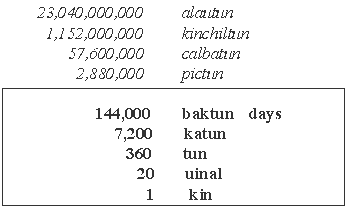
Therefore, dates expressed as, 9.0.0.0.0 selectively through 9.1.1.1.1, would be reflective of the following computations. [The mythical date 9.0.0.0.0 represents the departure from the land of Tollan, yet to be identified.]

Change the positional numbers in the dates, and the sums change correspondingly within the dates of the maya long count.
Many comparisons of the historically significant numbers are possible, but we have chosen to compare most of the numbers to those of the maya companion numbers (1366560 and 1385540). These numbers, according to scholars, represent the number of days in specific periods dealing with the calendar round (52 years times 360c days = 18980 days), yet their exact meaning is still being debated. The maya long count period is that of 1872000 days, which is also used in our comparisons. We have also employed the Nineveh number/fractal of 1959552, and the ancient Egyptian or, kemi 1296000 number, which is also the 9 baktun maya number (1296000 = 9 x 144000).
Within remainder math, the difference of terms is significant, as may be viewed in a comparison of some of the historically significant numbers of the ancient maya system. For some of the maya dates and numbers, we have consulted, Herbert J. Spinden, A Study of Maya Art: Its Subject Matter & Historical Development, [Dover, 1975, pp.155-247].
For a review of the dates of the maya long count in terms of day-counts and year-counts, we refer the reader to our essay, "Ancient Numbers: Some Computations" [Earth/matriX, Essay 123, April 4, 2000.]. In that essay we deal with some of the historically significant dates and the numerical differences between them. The same logic and neatness of design in the historically significant dates also appear in the numerical differences between these dates.
Consider some of the historically significant dates cited in the literature:

Some dates appear to be more significant than others. But, all of the dates reflect a specific, logical design based on the previously cited maya long count numbers. We shall select a few dates for analysis, in order to illustrate the scope of the system. The obvious characteristics of the system are that it represents a 20-base system, as viewed in the numbers, 1 and 20, and a system of doubling/halving the numbers as viewed in the numerical fractals: 36, 72, 144, (288, 576, 1152, 2304)…, suggesting an infinite array of categories.
If one is disinclined to think that the ancients employed the procedure of multiplication (20x), then computations in the system may be obtained through doubling and adding a zero at the end of each positional level. For, although, the dates are written horizontally in the literature, the dates appear in a vertical manner positional notation, with the numerical progression, higher to lower values, going from top to bottom. We shall follow the customary procedure of writing the dates in a horizontal fashion.
The mediatio/duplatio (doubling/halving) system was also employed on ancient Egypt, along with the procedure of trebling and dividing by three. Even though this procedure appears to be simple addition and subtraction, it essentially represents the concept of multiplication, that is, obtaining multiples of the numbers, but some authors have come to consider the procedure to be primitive and rather clumsy.
The previously cited dates reflect specific proportions and ratios. Chosen dates reflect a conscious design. Aside from the 360c calendar, another calendar of 260c days was employed. Now, consider the following ratios, and remember, we shall be employing the historically significant numbers often in their fractal expressions: as .0360, 36, 360, 3600, 36000, etc.:
| 260 / 187.2 | = | 1.388888889 |
| 189.8 / 136.656 | = | 1.388888889 |
| 189/136.08 | = | 1.388888889 |
From the start, it becomes obvious that dates and numbers have been selected as of specific quanta, packets of days.
360 / 259.2 = 1.388888889 [25920 Precession cycle number]
Immediately, from such a distinction, it is difficult to consider such a system as being clumsy or of a pre-mathematical nature. One even begins to suspect, that in such proportionality, keys to ancient knowledge may lie hidden:

The logic of the numbers may be establishing a system of knowledge that needs to be nudged a little in order to allow us in and be able to read its thoughts. So, we shall cite numbers and their fractal expressions from other ancient reckoning systems:

Each of these ancient systems is said to be unique and unrelated to one another. Yet, as we have seen elsewhere, the numbers and their fractal expressions interrelate with ease.
189 / 113.4 = 1.666666667 x 360 = 60
Spinden cites the 1404000 date as being all-important for other dates of the maya long count, the date around which most of the other dates revolve. In ancient Egypt, kemi, there is an historically significant count cited in the literature of 351. Let us halve down the 1404000 number by its fractal expressions:

This particular all-important maya date happens to represent a 351c as well. In appearance, because of the manner in which the system is designed, the maya dates appear to be representational of the 360c. But, in computational terms, each particular date may be relational to another historically significant count; even with regard to another reckoning system. Two other important ancient kemi numbers/counts are 729 and 378. Now, consider: 378 + 351 = 729.
The kemi 378c reflects the baseline of the Great Pyramid, as expressed in feet [756c feet], as it is often cited in the literature. We have already seen the maya long count calbatun number 57,600,000.
756 x 576 = 511056 = 1404 x 364
The 364c day-count has been cited as being the computational count employed in Mess-America for their reckoning system [364c + 1 = 365c].
The possibilities of computation are unending: 1404 x 584 = 819936
The 584c day-count refers to the ancient maya count for Venus' orbital cycle, and the 819936 represents a beautiful rendition of two significant day-counts: the k'awil, 819c and half the maya long count period 936c (1872 / 2 = 936).

Even if we employ apparently separated cycles, such as the Sothic 693c number and the 2028c year-count of the legend of the four suns from Meso-America, significant relationships appear:
| 693 x 2028 = | 1405404 | ||
| 1405404 - 1404000 | = | 1404 |
Different constant number series exist in order to translate from one historically number to another. The constant series 3, 6, 12, 24, 48, 96, 192…, serves this purpose between the 1404000 and the 1872000 maya long-count period numbers:
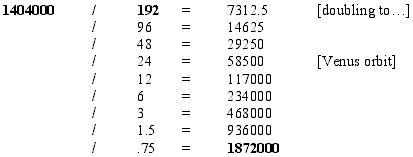
Hence, the 1404000 date represents three-quarters (75%) of the maya long count period, 1872000 date. Now, let us suppose that the kemi number 693 may be taken as a fractional expression, employing the floating decimal place:
1872000 x .693 = 1297296
This number is relevant to the historical date 1296000, common to both the ancient kemi and maya systems, by way of the 1001 count, often cited in the literature:
1297296 / 1001 = 1296
The 360c was also shared by the ancient kemi, and therefore it is logical that the 693c speaks in this regard:
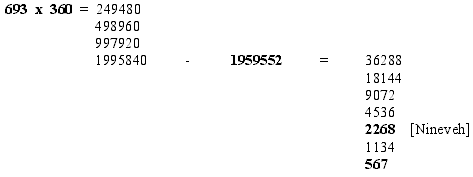
In this manner, we are able to observe how the different counts relate to one through simple mediatio/duplatio and remainder math.
Another historically significant kemi count concerns the number 441c. Immediately, one draws attention to the fact that the ancient reckoning system reflects numbers with same integers arranged in different positions. For example, we have already viewed the kemi 756c, the maya 576c, and the Nineveh 567c, a case in point. Consider then, the possibility of viewing the 1404 maya fractal number in relation to the 4410c of the ancient kemi (retaining the zero simply for symmetry's sake]. Another unsuspecting relationship appears between the ancient kemi and maya reckoning systems by way of the expression of pi (3.141592654), as we know it today:
44100 x 3.141592654 (pi) = 138544.236 [1385540, Maya companion number]
The 1385540 maya companion number, then, represents a 99.992953 % of today's figure for pi. But, this is not the only relationship between these ancient kemi and maya numbers. The picture becomes even more complete as we observe the following:
1404 x 3.141592654 (pi) = 4410.796086 [maya 1404 : pi : kemi 4410]
Now, if the 4410 and 1404 fractal counts are employed, then pi would represent the following amount:
One could imagine the following computation, then, with remainder math:
3.1410256 plus .000567 = 3.1415926
The historical record is silent on these points. And, most scholars are reluctant to believe that the ancients were capable of such computations with the ancient reckoning systems. Nonetheless, the numbers and their fractal expressions allow for such a thesis.
The encoding of numbers, then, may be quite simple in fact. Consider the relationship drawn from the 65c [maya], the 27c [kemi] and the 36c [maya, kemi].
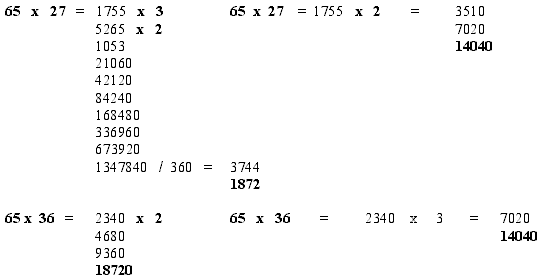
The combined method of doubling and trebling lies documented within the record of ancient Egypt. The calendar round 52c is signified by 13 x 4, while the 65c represents 5 x 13; even more interesting is to note that, 18980 days x 5 equals 94900 divided by 65c yields the 1460 Sothic number.
The numbers and their fractal expressions are teaching us of the interrelated design within the ancient reckoning system. Apparently unconnected numbers among different systems are completely relational through the basic procedures of mathematics. The different systems appear to function as a single system.
Ancient Reckoning and the Speed of Light
This heading in itself shall probably set some people off into great surprise, saying, "now, wait a minute". If not a minute, then, let us ask ourselves about a light year. The case may be that all of those enormously long numbers in the ancient reckoning systems may just be speaking in terms of the speed of light and light years. Some scholars have a difficult time even entertaining the idea that the ancients may have measured time accurately in terms of orbital periodicity of the planetary bodies in our solar system. To even suggest that their numbers may reflect considerations or measurements of the speed of light only turns them off even more.
But, just for a moment, let us examine some of the numbers and their performance regarding the numbers related to our own system of time and the measurement of the speed of light. As we stated early on, the speed of light is measured today at 186282.397 miles/second by way of its conversion from 2.99792458 x 1010 cms/sec. It is quite simple to obtain packets of numbers according to the specific day-counts of the ancient past.
186282.397 miles x 60 second x 60 minutes x 24 hours = 1.6094799110 miles/day [scientific notation]
To be more brief:
186282.397 miles x 86400 seconds/day = 1.6094799110 miles/day To be fair, we should note that the 60c, the 24c, and the 86400c all represent historically significant numbers or fractal expressions (the 864 being twice the 432 Consecration number, and representing a multiple of the ancient kemi series: 864, 432, 216, 108, 54c). Therefore, as one may expect, the numbers are going to reflect in part the ancient reckoning numbers and their fractal expressions.
However, matters become interesting right from the start. A 52c year-count calendar round (52c years) consists of 18980 days. And, the Legend of the Four Suns speaks about a period of 676 years, which is essentially 13 calendar rounds (13 x 52 = 676):

Now, consider this number, which is close to the Nineveh number 195,955,200,000,000:
1985615.365 - 1959552 = 26063.365
There is a more direct way to look at the speed of light as of the Nineveh number:
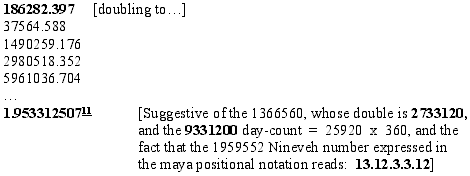
Other ancient historically significant numbers in different systems refer to the 31104, 15552, 7776, 3888 series. In a 360c day-count year, there are 31104000 seconds. While, interestingly enough, in our 365.25c year, there are 31557600 seconds (note, the 315c and 576c counts together).
Therefore, 186282.397 miles/second x 31104000 seconds = 5.79412767612 /year:360c. The product is suggestive of the maya fractal 576c, and means that that is the distance that light travels in miles during a 360c-day year.
Now, what if the maya employed a different measuring rod for their computations. In other words, the distances remain the same, but instead of miles, they would be measuring with a modified measuring stick. Hugh Harleston proposed the idea of the maya unit of measurement as being the twelfth root of two (1.059463094 meters). If we divide the fractal 579.412676 by 576c, we obtain, then, a similar number: 1.005924785 as the answer. The 1.005924785 number to the 9th power is 1.054604402, which is extremely close to the Planck Constant over 2pi or the Atomic Unit of Action (1.054571596).
Now, obviously, this cannot be a valid relationship, but we are simply illustrating how a distinct measuring rod may intervene in order to obtain the same measurements. In other words, let us see what the speed of light would be in the modified maya long-count system.
The procedure would be:
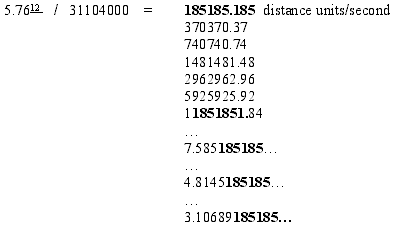
With these numbers, various points come to mind. If the ancients were encoding a message or information into their artwork to be transmitted to another civilization, somewhere down the time line of history, it would not seem logical that they would limit their communication to merely telling us what is the value for the speed of light. Surely, they would have concluded that any society coming after them would itself happen upon such knowledge. The case might be that the encoded information is modifying a datum regarding the speed of light, something that would be of value to another civilization.
For, it may be reasoned, that if the civilization coming later did not know the speed of light, then it would not matter having it encoded into the artwork, since its value would probably go unrecognized anyway. The supposition is that, instead of merely stating the corresponding value of the velocity of light, it may be of interest to communicate some other idea around the concept of the speed of light. For example, at which speed is it possible to travel through space, just under the speed of light, without turning into light as Einstein suggested.
Interestingly enough, the difference between the maya figure 185185.185 and 186282.397 is 1097.212, which is extremely close to the series 351c.

The 185185.185 winds up playing a significant role throughout the computations of the maya, kemi and Nineveh numbers/fractals.

Consider, further, the 260c day-count and the all-important historically significant number, 1404000.
260 / 1404 = .185185185...
Hence, at the speed of 185185.185 distance units (miles?) per second, light travels in 26000 years (360c day-count years) 1.459999999810 miles(?) (or, 14976 fractal rounded off), and the fractal 1872c would represent one-eight of that precession figure. Note: 14976, 7488, 3744, 1872, 936....
185185.185 x 60 x 60 x 24 = 1.59999999810 x 9360000 days = 14976c fractal
[i.e., 1.49759999916.] Further, note that 1497600 - 1404000 = 93600
The ancient reckoning numbers appear to be relational in different formats. Notice the miles traveled by light as of the 567c and the actual speed of light (186282.397 miles/second).

Now, notice the last fractal expression: 116809614. Consider the square root of the 1366560 maya companion number: 1168.999572
| 1168.999572 | = | 1366560 |
| 1168.09614 | = | 1364448.592 |
Hence, light travels 9.1257510912 miles in 567 days, a numerical multiple (or fractal) of the 365c day-count numbers. During 2268 days (the Nineveh number), light will travel 3.65030043613 miles, at the cited speed of light given today (186282.397 miles/second). Given that ancient day-counts appear to have been duplicated in year-counts and cycle-counts, then it would appear that the choice of certain day-counts (such as the 567c) enshrouds specific data relevant to today's world.
For example, if we take the 9490000 days from the Precession's 26000 years times 365 days, the haab day-count, he following obtains:
86400 seconds times 9490000 = 8.1993611 seconds/Precession
The combined counts of k'awil 819c and 936 are seen in a single figure.
8.1993611 x 186282.397 = 1.52739643517 miles/Precession 365c
Note other computations:

Essentially, the same numbers are appearing on the left side of the equation as on the right side. In other words, there is a translation between days and miles, or time and distance. From this, one may know the figure for which light travels as of the day-count itself:
756 x 16 = 1209
whereby all the terms are expressed in fractals, and the speed of light is given as 185185.185 in this case.
For the speed of light to be given at the figure in miles, 186282.397, one would simply multiple the day-count by a factor of 1.60947991, which in said case simply represents the number of miles traveled by light in one day:.
567 x 16.094799110 = 9.1257510912 fractal expression
whereby variations would become available in changing any one of the terms of the equation.
Observations
In this essay, we have expanded upon some of the relationships contained in earlier essays regarding the day-counts of the different ancient reckoning systems. As we have illustrated the different day-counts, year-counts and cycle-counts appear to be inter-related among the different ancient reckoning systems. The interconnected nature of the systems suggests the possibility that the different systems either constituted a single system or, descended from a proto-system, unknown to us today.
It is difficult to believe that the manner in which different, historically significant numbers and fractals are relational, that this may be due to mere happenstance. Currently, more and more scholars are beginning to explore the scientific nature of the ancient reckoning systems, and contemporary views about the past are changing rapidly. The age-old idea that all of the ancient cultures and civilizations never enjoyed any kind of contact, due to their being dispersed around the globe, is slowly being chipped away at, thus being replaced by a more exact account of the past.
Too many coincidences exist among the ancient cultures for these coincidences to go unnoticed or, for them to disregarded as a mere coincidence. When one finds three different ancient reckoning counts to be based on the same integers (756c, 576c, 567c), although each arranged in a distinctive manner, somehow such a coincidence of terms defies logic. Also, to find that the ancient Egyptians employed a 360c day-count almost exactly in the same manner as the Meso-American 360c day-count, with both systems adding on an extra five days, again challenges one's sense of historical proportion.
Aside from the obvious similarities in the ancient day-counts, one then happens upon the fact that nature herself employs similar numbers in different levels of matter and energy. In this essay, we have shown how one may employ the ancient system in order to achieve a translation between the day-counts and measurements of distance which approach the numbers related to the speed of light and some of the historically significant day-counts.
Understandably, it is difficult to imagine anyone accepting the speculative idea that the ancients knew the speed of light, and not only that, but devised a reckoning system that allowed for its computation. Such a thesis would shatter the parameters of historical interpretation achieved to date. Nonetheless, it is significant to note that the ancient reckoning system can allow for and accommodate such analyses at many different levels and in distinct manners. So, even though this may not have been the case in antiquity, the fact remains that the ancient reckoning system does comply with the needs of such levels of computation.
The most interesting point in our assessment of the reckoning systems is that the historically chosen dates that appear in the record reflect computations that are relevant to a more profound knowledge of the Universe. In other words, even though these numbers and dates appear to be symbolically established, that symbolism reflects real numbers in the real world. For such a result to have been the product of happenstance, one can only imagine what the laws of probability would state in this regard.
As we have seen in our previous analyses, the ancient reckoning numbers appear in many different fields: astronomy, physics, radioactive decay, chemistry, differential equations, computers, and now in the treatment of the speed of light. One would have to stretch the imagination quite a bit in order to accept the possibility that the ancient cultures knew such themes. But, what one may tentatively conclude is that the ancient reckoning numbers reflect the behavior of matter and energy (at whichever level the ancient maya and kemi carried out there studies), and for this same reason, we find the numbers in other fields of study of matter and energy. The maya and kemi probably did not study all of these fields, but the numbers that they happened upon are the numbers in Nature throughout these many different objects of study.
***************************************
Science in Ancient Artwork
Essay 124
Ancient Encoded Numbers: The Speed of Light
April 6, 2000
©2000-2015 Copyrighted by Charles William Johnson. All Rights Reserved
Reproduction prohibited without written consent of the author.
| Home | Books | Author |